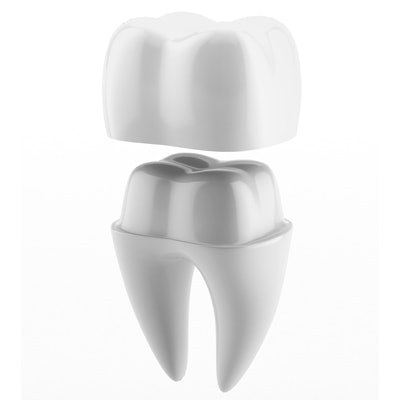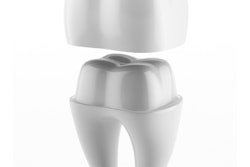
Hybrid ceramic materials may be an alternative to established materials for posterior restoration crowns. However, questions remain about these hybrids' ability to hold up under high masticatory forces. In a new study, researchers sought to analyze the fatigue damage that occurs with hybrid CAD/CAM composites.
They compared three of these materials, also known as monolithic CAD/CAM composites, with a lithium disilicate ceramic material and a polymer-based ceramic material to see which withstood fatigue damage better. The CAD/CAM composite blocks showed notably lower fatigue damage, the researchers found.
“The CAD/CAM composites showed the largest area without microcracks.”
"The CAD/CAM composites showed the largest area without microcracks," wrote the authors, led by Dr. Maximiliane Amelie Schlenz of the department of prosthodontics at the dental clinic of Justus Liebig University in Giessen, Germany (Journal of Prosthodontic Research, March 13, 2019).
The researchers divided 80 extracted human third molars into five groups (16 in each) for testing. The groups consisted of the two ceramic materials, the lithium disilicate ceramic (IPS e.max CAD, Ivoclar Vivadent) and the polymer-based ceramic material (Vita Enamic, Vita North America), and three different CAD/CAM composite blocks: Lava Ultimate (3M), Brilliant Crios (Coltene), and Cerasmart (GC America).
The crowns were adhesively cemented with a corresponding luting system on the teeth after milling. Half of the specimens were light-cured, and the others were chemical-cured. A mouth-motion simulator applied dynamic cyclic loading between 50 newtons (N) and 500 N for a period of 1 million cycles. Researchers then used a dye penetration test to reveal any damage. They also assessed radial cracks at the cementation surface.
While all specimens showed fatigue damage in the occlusal contact area, the three CAD/CAM composites had a significantly greater area without damage compared with the other two materials (p < 0.05), they reported.
When the number of radial cracks was measured, the IPS e.max and Vita Enamic crowns had more cracks at the cementation interface in both curing modes, whereas all three monolithic CAD/CAM materials showed only radial cracks with chemical-cured luting cement.
The authors acknowledged that this was an in vitro test and that further research was needed. However, the study results suggested that the CAD/CAM composites held up at least as well as other composite materials.
"Even under simulated higher masticatory forces, CAD/CAM composites showed the greatest damage-free area, especially if a light-cured luting system was used," they wrote.



















